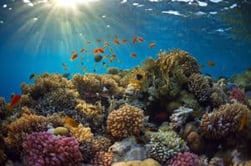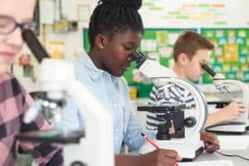Weathering, Erosion, and Deposition Inquiry Lab
Middle School Inquiry Lab on Weathering, Erosion, and Deposition
In this lab students will learn about the stalactites and stalagmites found at Natural Bridge Caverns near San Antonio, Texas. Students will set up a demonstration showing the formation of both stalactites and stalagmites, then analyze how erosion and deposition played a part in the formation.
Each inquiry lab will contain an essential question that will drive the lesson and make students think. For this lesson, the essential question is:
- How does erosion and deposition play a part in the formation of stalactites and stalagmites found in Natural Bridge Caverns?
BACKGROUND INFORMATION AND MATERIALS LIST:
Students will begin the lab by reading the essential question and background information. This can be done individually, as lab groups, or as a whole class. If you consider lab groups, you also might include some type of whole class formative checks before digging into the lab.

Materials List:
- 160 grams of magnesium sulfate (Epsom Salt)
- 250 mL boiling distilled water
- 1 sheet of aluminum foil (12″ long)
- 1 piece of unwaxed twine, 12″ long
- 2 large paper clips
- 500 mL beaker
- 2 8 oz Styrofoam cups
- stirring rod
- beaker tongs
- goggles
- triple beam balance or digital scale
PROCEDURE:
In this inquiry lab students will recreate in 24 hours what took nature thousands of years to do. Students will create a solution that will make mini versions of stalactite and stalagmite formations.
This two-day inquiry lab will require students to set up their demonstration on day one using twine, Styrofoam cups, paper clips, and a solution of boiling water and magnesium sulfate. While the twine is soaking, students will have to distinguish the difference between erosion and deposition.
On day two, students will come back to their stations to make observations and record what happened after 24 hours. Students will sketch out the end result and will have to think about how erosion and deposition played a role in what they see.
CHECK FOR UNDERSTANDING:
At this point in the lab, students will be checked for understanding by answering questions about their findings. Here is one that comes with the lab:
- What is the difference between erosion and deposition?
CONCLUSION
Students will go back to the essential question and write a CER (Claim, Evidence, Reasoning) to conclude the lab. Once completed, students will reflect back on their learning by answering the following questions:
- Does the formation of stalactites represent mechanical or chemical weathering?
- What stage of the stalactite formation is an example of erosion?
- What stage of stalagmite formation is an example of deposition?
MODIFIED AND INDEPENDENT INQUIRY VERSIONS
All of the Kesler Science inquiry labs come with three different modification levels. Each lab is differentiated using the icons below.
STANDARDS ALIGNMENT
TEKS: 7.8B – Analyze the effects of weathering, erosion, and deposition on the environment in ecoregions of Texas.

Download Over $100 in FREE Resources
For Middle School Science
Simply create a login below and gain immediate access to a selection of our Kesler Science product line worth $100 - for FREE. There's a full version of every product type! You'll also join tens of thousands of middle school science teachers who receive timely tips and strategies straight to their inbox.






